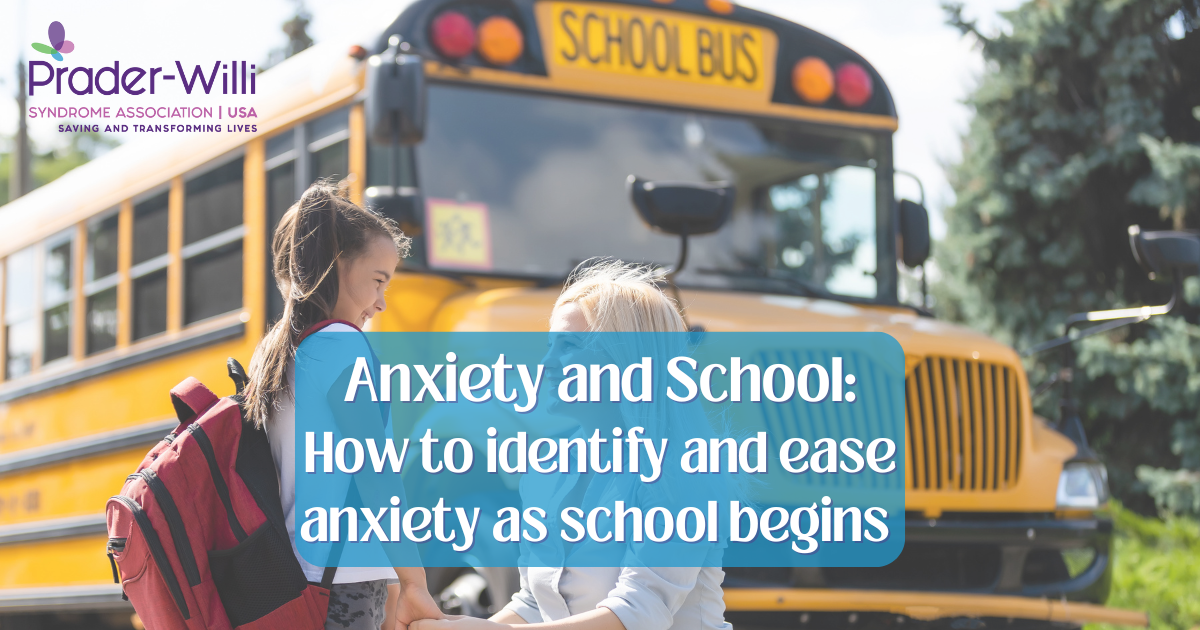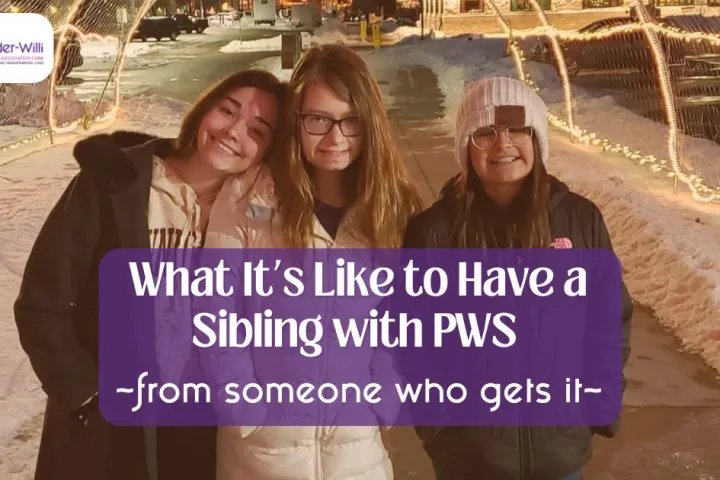The school year is fast approaching for some families, and well underway for others. Whether your loved one is returning to a familiar school with familiar faces, or beginning a new adventure in an unknown place, they may be feeling a mix of excitement and trepidation. Change and the unknown can be very difficult for our loved ones as they face a new day of new people, new places, and new expectations. Anxiety levels may be creeping up, or for some families, rocketing out of orbit. Do you know how to spot the symptoms of anxiety in people with PWS?
Anxiety may look like:
- *Skin picking or increase in skin picking (nails, skin, lips).
- *Perseveration (asking the same questions or becoming stuck on a topic).
- *Flare up of OC tendencies (i.e. organizing and re-organizing trinkets, tying and retying knots).
- *Sleep disturbances (sleeping more or difficulties with falling or staying asleep) Any change can indicate anxiety or worry.
- *Stomach aches or other physical complaints with no other symptoms.
- *Increase in defiance or rigid behavior or the individual shutting down.
- *Increase in meltdowns and/or irritability.
- *Forgetting how to do something they once had mastered (i.e. tying shoes). This skill will come back.
How we can help ease their anxiety:
- *Talk with them about what the school day will look like (schedules, people, mealtimes). Provide a written schedule they can use as reference.
*Make a trip to the school before the year begins so they can get familiar with the surroundings.
*If possible, meet with some teachers and/or classmates before the year begins. Go to a playground, wander the mall, or do some fun, relaxing activity where they can connect and become a little more familiar with the person. - *Movement and exercise help produce calming chemicals and hormones and moves anxiety through our bodies so we can settle into a calmer state.
- *Be sure they are getting enough sleep (turn off screens a few hours before bed, set a decent bedtime and stick to that).
- *Get sunshine and fresh air early in the day and throughout if possible. This will help with sleep as well.
- *Set aside a space and time to let them ask and repeat their questions but set a limit to not feed the perseveration.
- *Role play interactions they may have so they have some practiced dialogue and responses, also helping these situations feel more familiar.
- *Ask what they think would help.
- *Use social stories to help your loved one become familiar with situations and experiences they may encounter.
- *Stay positive and try not to show your fears or frustration.
- *If possible, identify a “go to person” at the school. This would be someone they can go to if they are feeling unsettled or anxious. Be sure that this person knows they are the “go to” person and appropriate ways they can respond if your loved one reaches out to them.
- *Use sensory play and calming activities to help ease anxiety (sand / water play, deep breathing, meditation, squeeze balls, etc.).
- *If possible, have the child join in the IEP, or part of the meeting to share their concerns. If this is not possible have them record their concerns or write them out for the parent to share.
Address your own anxiety as well.
As parents and caregivers, you may be experiencing anxiety as well. Don’t be afraid to reach out to the school and schedule a meeting to ask any questions you may have. Reach out to other parents via Facebook groups or other social channels to hear other experiences. If you have concerns about services or your child’s IEP, please reach out to PWSA | USA via our email at info@pwsausa.org.
Many of the techniques for calming anxiety in our loved ones can help ease our own anxiety. Try to include movement or exercise in your day, get plenty of sleep, avoid screens at bedtime, get fresh air and sunlight throughout the day, and practice some calming breathing techniques to use when your anxiety feels heightened.
Anxiety is a part of life, especially with PWS. Thankfully, there are many tips, tricks, tools, and techniques we can use to help ease the anxiety we experience.
Share this!





 Jennifer Bolander has been serving as a Special Education Specialist for PWSA (USA) since October of 2015. She is a graduate of John Carroll University and lives in Ohio with her husband Brad and daughters Kate (17), and Sophia (13) who was born with PWS.
Jennifer Bolander has been serving as a Special Education Specialist for PWSA (USA) since October of 2015. She is a graduate of John Carroll University and lives in Ohio with her husband Brad and daughters Kate (17), and Sophia (13) who was born with PWS. Perry A. Zirkel has written more than 1,500 publications on various aspects of school law, with an emphasis on legal issues in special education. He writes a regular column for NAESP’s Principal magazine and NASP’s Communiqué newsletter, and he did so previously for Phi Delta Kappan and Teaching Exceptional Children.
Perry A. Zirkel has written more than 1,500 publications on various aspects of school law, with an emphasis on legal issues in special education. He writes a regular column for NAESP’s Principal magazine and NASP’s Communiqué newsletter, and he did so previously for Phi Delta Kappan and Teaching Exceptional Children. Evan has worked with the Prader-Willi Syndrome Association (USA) since 2007 primarily as a Crisis Intervention and Family Support Counselor. Evans works with parents and schools to foster strong collaborative relationships and appropriate educational environments for students with PWS.
Evan has worked with the Prader-Willi Syndrome Association (USA) since 2007 primarily as a Crisis Intervention and Family Support Counselor. Evans works with parents and schools to foster strong collaborative relationships and appropriate educational environments for students with PWS. Dr. Amy McTighe is the PWS Program Manager and Inpatient Teacher at the Center for Prader-Willi Syndrome at the Children’s Institute of Pittsburgh. She graduated from Duquesne University receiving her Bachelor’s and Master’s degree in Education with a focus on elementary education, special education, and language arts.
Dr. Amy McTighe is the PWS Program Manager and Inpatient Teacher at the Center for Prader-Willi Syndrome at the Children’s Institute of Pittsburgh. She graduated from Duquesne University receiving her Bachelor’s and Master’s degree in Education with a focus on elementary education, special education, and language arts. Staci Zimmerman works for Prader-Willi Syndrome Association of Colorado as an Individualized Education Program (IEP) consultant. Staci collaborates with the PWS multi-disciplinary clinic at the Children’s Hospital in Denver supporting families and school districts around the United States with their child’s Individual Educational Plan.
Staci Zimmerman works for Prader-Willi Syndrome Association of Colorado as an Individualized Education Program (IEP) consultant. Staci collaborates with the PWS multi-disciplinary clinic at the Children’s Hospital in Denver supporting families and school districts around the United States with their child’s Individual Educational Plan. Founded in 2001, SDLC is a non-profit legal services organization dedicated to protecting and advancing the legal rights of people with disabilities throughout the South. It partners with the Southern Poverty Law Center, Protection and Advocacy (P&A) programs, Legal Services Corporations (LSC) and disability organizations on major, systemic disability rights issues involving the Individuals with Disabilities Education Act (IDEA), Americans with Disabilities Act (ADA), and the federal Medicaid Act. Recently in November 2014, Jim retired.
Founded in 2001, SDLC is a non-profit legal services organization dedicated to protecting and advancing the legal rights of people with disabilities throughout the South. It partners with the Southern Poverty Law Center, Protection and Advocacy (P&A) programs, Legal Services Corporations (LSC) and disability organizations on major, systemic disability rights issues involving the Individuals with Disabilities Education Act (IDEA), Americans with Disabilities Act (ADA), and the federal Medicaid Act. Recently in November 2014, Jim retired.